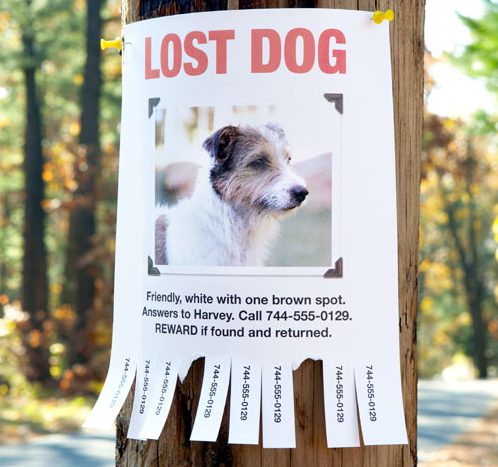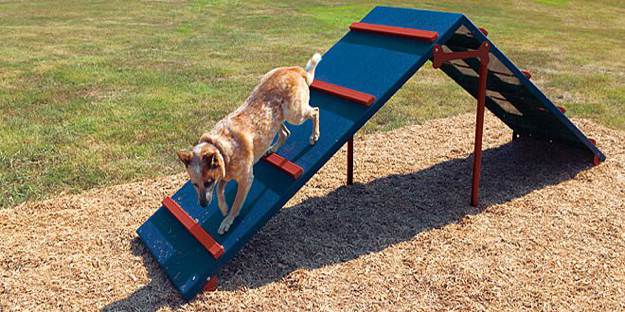Written by Honey Souza, Humane Education Coordinator
PART TWO: Searching for Lost Pets
A three-part series of what to about missing pets.

Last month we covered some helpful hints for preventing your pet from getting out and getting lost. Hints like ensuring your pet is spayed or neutered to reduce the urge to roam.
Unfortunately, even the most attended-to pets can go missing. If that’s the case, don’t panic. Take a breath, clear your head, then get to work because expedience is key.
- Look: First and foremost, get out and look around your neighborhood. Don’t be shy about going door to door asking permission to look in/around their yards. Don’t forget to look up in trees and on roofs. Pets are more inclined to return to familiar sounds… shouting out their names with a twinge of panic in your voice is not a familiar sound and may even make them more inclined to stay away. Traverse a five block radius while engaging in common conversation with the occasional yet normal recall cue. Bring a flashlight to look in dark areas like under porches.
- Call: Call your local animal control to ask if your pet has been turned in. Don’t stop there, go to the shelter to check for yourself. Two people can look at the same pet and see two different breeds. While you’re there, you’ll want to fill out a missing pet report in case your pet comes in later. Inquire with neighbor city shelters. If someone has stolen your pet, they might take it to another town.
- Access: Leave garage doors cracked and pet doors unblocked. Open your windows and keep noise down in your house so that you have a better chance of hearing their calls to come in, especially late at night.
- Check the Net: Check online. First stop: Facebook. The following groups listed below are dedicated specifically to returning lost pets to their families. Then you’re going to want to check Craigslist.org. Be sure to check, the categories of “Lost & Found”, “Pets”, and “Free”.
- Post It: Posters really do work. Post them around your neighborhood, library, and vet offices. Print out baseball type handbill of your pet to give to neighbors in the chance that they will see it later on. Of course you’re going to want to create your own “Lost Pet” posts on the internet, too. Be sure to use a variety of pictures with different angles and good lighting. Don’t forget to mention if your pet is on any medications or has dietary restrictions.
- Smell: Leave strongly-scented items outside such as your pet’s favorite pillow, toy, or favorite treat, even litter boxes. Cook up something meaty that has a strong aroma. While it’s still hot put it outside. You may attract the rest of the four-legged neighbors, but it’s worth it if your pet is amongst them. Then share some of that with your pet.
- Keep Looking: Check your neighborhood, local shelter, Facebook, craigslist, and other online sources every day. It might take hours, days, or weeks for a found animal to be reported. Many people assume that just because a loose animal doesn’t have a collar, it is unwanted or abused. They may think they are helping by taking it in and/or re-homing it themselves.
Stop to think “why”? Your pet could have run away from a fearful situation. Very often they’ve run off to answer nature’s call to mate. Often when animals who have free roam of the neighborhood run off, it’s because they are not feeling well or are injured. Regular check-ups and constant monitoring of your pet’s health could help prevent that. This is also why once your pet does come home, you’ll want to take it to the vet as soon as possible.
For Cats:
They are most often closer than you think. There’s a good chance that they’ve just discovered a new hiding place in your house, tastier food, and a warmer couch five houses down, or a new friend. Cats are very resourceful animals and can do well on their own for days, or even weeks. Most cats eventually return on their own within about five days.
Many neighborhoods have their own neighborhood watch email/text alert system. While going door to door, find out if yours does and get the contact info to be part of it. If your neighborhood does not have a watch system in place, take the initiative and make one.

 Agility courses can be a great training and exercise tool for you and your pup! They can include a variety of equipment that increases your dog’s athletic ability and stamina, while strengthening the team communication between handler and canine. Basic equipment that you can find on agility courses are jumps, tunnels, a-frames, teeters, weave poles, and dog walks.
Agility courses can be a great training and exercise tool for you and your pup! They can include a variety of equipment that increases your dog’s athletic ability and stamina, while strengthening the team communication between handler and canine. Basic equipment that you can find on agility courses are jumps, tunnels, a-frames, teeters, weave poles, and dog walks.
